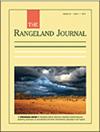Processes underpinning natural capital account compilation highlight the potential for low-input grazing to mitigate farm carbon emissions while also improving biodiversity outcomes
IF 0.9
4区 环境科学与生态学
Q4 ECOLOGY
引用次数: 1
Abstract
Remnant woodland areas are commonly part of livestock grazing operations in temperate Australia. These remnant areas can store substantial amounts of carbon and have important biodiversity value, but are at risk of ongoing decline due to nutrient enrichment, overgrazing, clearing of woody debris and lack of tree recruitment. The process of compiling experimental farm-scale natural capital accounts (NCA) for 11 wool-growing businesses in temperate Australia demonstrated that some wool growers may be managing these areas in ways that sustained, and at times regenerated, carbon and other natural values. When managed sensitively, these largely native areas provide forage and shelter for livestock production while carbon and associated biodiversity is also protected, and in some cases regenerated. The farm-scale NCA process highlighted that for some farm businesses net sequestration of carbon can occur at a farm-scale, substantially owing to the management approach applied to these remnant areas. The process highlighted the potential for livestock grazing approaches underpinned by the ecosystem services provided by native grasses, forbs and woodlands (i.e. low-input rather than nutrient enrichment and pasture modification) to contribute to balancing carbon emissions from other areas of more intensive management within a farm business. With the current momentum worldwide aimed at achieving net zero emissions, there is an opportunity that has not existed previously to conserve, and sometimes regenerate, these remnant woodland areas on farmland. This could contribute to reversing a crisis of biodiversity loss in this threatened ecosystem while also helping farm businesses to reduce overall carbon emissions.支持自然资本账户编制的过程强调了低投入放牧减少农场碳排放的潜力,同时也改善了生物多样性成果
在温带的澳大利亚,残留的林地通常是畜牧业的一部分。这些残留地区可以储存大量的碳,具有重要的生物多样性价值,但由于营养丰富、过度放牧、清除木质碎片和缺乏树木补充,这些地区面临着持续减少的风险。为温带澳大利亚的11家羊毛种植企业编制试验性农场规模自然资本账户(NCA)的过程表明,一些羊毛种植者可能正在以维持碳和其他自然价值的方式管理这些地区,有时还会再生碳和其他天然价值。如果管理得当,这些以原生为主的地区为畜牧业生产提供了饲料和住所,同时碳和相关的生物多样性也得到了保护,在某些情况下还会再生。农场规模的NCA过程强调,对于一些农场企业来说,碳的净固存可以在农场规模上发生,这在很大程度上是由于对这些剩余地区采用了管理方法。这一过程强调了以原生草、禁种植物和林地提供的生态系统服务为基础的畜牧业放牧方法的潜力(即低投入,而不是营养丰富和牧场改良),有助于平衡农业企业内其他更密集管理领域的碳排放。鉴于目前全球范围内旨在实现净零排放的势头,现在有一个前所未有的机会来保护,有时甚至再生这些农田上的残余林地。这可能有助于扭转这一受威胁生态系统中生物多样性丧失的危机,同时也有助于农业企业减少总体碳排放。
本文章由计算机程序翻译,如有差异,请以英文原文为准。
求助全文
约1分钟内获得全文
求助全文
来源期刊

Rangeland Journal
环境科学-生态学
CiteScore
2.90
自引率
8.30%
发文量
14
审稿时长
>36 weeks
期刊介绍:
The Rangeland Journal publishes original work that makes a significant contribution to understanding the biophysical, social, cultural, economic, and policy influences affecting rangeland use and management throughout the world. Rangelands are defined broadly and include all those environments where natural ecological processes predominate, and where values and benefits are based primarily on natural resources.
Articles may present the results of original research, contributions to theory or new conclusions reached from the review of a topic. Their structure need not conform to that of standard scientific articles but writing style must be clear and concise. All material presented must be well documented, critically analysed and objectively presented. All papers are peer-reviewed.
The Rangeland Journal is published on behalf of the Australian Rangeland Society.
 求助内容:
求助内容: 应助结果提醒方式:
应助结果提醒方式:


